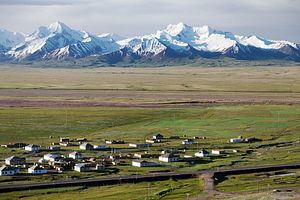Every few years the simmering tensions along the pockmarked, Soviet-delineated borders in Central Asia’s Fergana valley flare up. Tuesday, in southern Kyrgyzstan’s Batken region, Uzbek border guards reportedly killed a Kyrgyz citizen — identified by Uzbek officials to Interfax as 22-year old Mansur Makhmudjon Uulu — when he attempted to “smuggle ten tons of potatoes and five tons of dried apricots” out of Sokh district, an exclave of Uzbekistan surrounded completely by Kyrgyz territory. The population of Sokh is mostly ethnic Tajiks.
According to reports from RFE/RL’s Kyrgyz Service, a second Kyrgyz man was taken into custody by the Uzbek border guards and a third escaped into Kyrgyzstan.
There are frequent flare-ups all along the jagged borders between Kyrgyzstan, Uzbekistan, and Tajikistan in the fertile but restive Fergana valley — especially around the various exclaves. The border, delineated by the Soviet Union and inherited after its collapse by the independent states of Central Asia, has not been completely demarcated. Last February, Trend reported that Kyrgyzstan and Uzbekistan were intensifying efforts to demarcate the border:
Currently, Uzbekistan and Kyrgyzstan have delimitated some 1,058 kilometers of the border (the total length of the border is 1378.44 kilometers), which accounts for over 70 percent of the total length of the two countries’ border. Nearly 50 sections with about 300 kilometers length haven’t been delimitated.
The pieces that remain in question continue to add to tensions that complicate the big hopes of some for regional economic integration.
Last summer, about 70 kilometers west of Sokh, Kyrgyz and Tajik border guards clashed near the Tajik exclave of Vorukh. According to IHS Janes:
The confrontation began after approximately 30 Vorukh residents attempted to lay a water pipe from the Karavshin River in Kyrgyz territory to the village of Bedak in the Tajik exclave. Kyrgyz border guards ordered the work to stop because it was in the disputed area. They encountered resistance and fired warning shots.
The year before, in January 2013, Sokh was the site of a bizarre series of events. Uzbekistan says that Kyrgyz border guards opened fire on Uzbek citizens who had been protesting the placement of electricity towers by the Kyrgyz guards. The Kyrgyz said their border guards were attacked and that 40 Kyrgyz citizens (RFE/RL reported 30) were taken hostage by residents of the exclave. The hostages were released a day later and eventually the border reopened.
Sokh was created in 1955, according to RFE/RL. Local legend holds that “the territory was lost by a Kyrgyz Communist Party official in a card game with his Uzbek counterpart.” Other say it made sense to assign the area to Uzbekistan because the roads running along the Soh river connected to Uzbekistan to the north rather than going through the rugged Kyrgyz territory to the east and west of the area in question.
In 1999, Uzbekistan claimed that militants from the Islamic Movement of Uzbekistan (IMU) were using Sokh as their base to attack Uzbekistan and Kyrgyzstan. Earlier that year, Tashkent had been rocked by a series of car bombings attributed to the IMU. Uzbekistan began mining the borders around Sokh, angering the Kyrgyz who claim Uzbekistan placed mines on its territory.

































